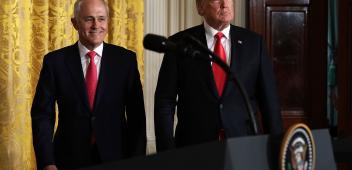It’s time to consider negative interest rates to bolster growth
It’s time to consider negative interest rates to bolster growth
Leon Berkelmans
The Australian
12 September 2015

Executive Summary
The world waits, feverishly, for next week’s Federal Reserve meeting. The FOMC could increase interest rates for the first time in almost a decade. Martin Sandbu, of the Financial Times, called this decision “the single most important imminent economic policy decision in the world”. But there’s an even more important issue in plain sight. And we are not talking about it.
It’s the zero lower bound on interest rates. The Fed will be increasing interest rates from that bound, where rates have been stuck since the end of 2008. Other major economies are stuck at the zero lower bound too. Japan has been there for a couple of decades. The ECB hit the zero lower bound a few years after the Fed, but it’s there now, and unlikely to exit any time soon.
Some European central banks have been able to implement rates slightly below zero, showing that small negative returns will be tolerated, but there is a limit.
In any case, the zero lower bound has been costly. One analysis by Federal Reserve economists suggested that unemployment would have been 3 percentage points lower in 2012 had they been able to cut interest rates to negative 4 per cent.
One might adopt the position that the global financial crisis was a freak event. We haven’t seen such extremes in central bank interest rate policy before. Once economies exit the current situation, we are unlikely to see them again in the future. I think such a position is wrong.
In 2012, in their World Economic Outlook, the IMF documented the gradual but sustained and relentless decline in real long-term interest rates over the last three decades.
This decline in real long-term rates will translate to lower short-term nominal rates, on average, over the cycle. That means the zero lower bound is more likely to be hit. This is true, no matter where you are. Every economy is likely to face this new future.
There are several possible responses to these developments, among them: rely on unconventional monetary policy, raise the inflation target, pursue fiscal activist policy, implement institutional changes so that negative interest rates are possible, or change the monetary framework away from inflation targeting.
Unconventional monetary policy, namely quantitative easing and forward guidance, has probably had its successes. A different study by Federal Reserve economists has suggested that unconventional policies subtracted one and a quarter percentage points from the unemployment rate.
However, there is uncertainty about how unconventional policies work. For example, in 2012 Michael Woodford, the doyen of academic monetary economists, suggested that quantitative easing, in particular, did not have the effects typically ascribed to it.
Moreover, he claimed that unconventional policies often caused financial markets to become more pessimistic, an unsavoury side effect for a policy that’s supposed to be stimulatory. The debate and academic inquiry rages on, and more work will be needed before economists can claim to have mastered unconventional policy.
Raising the inflation target would help. Olivier Blanchard, outgoing chief economist at the IMF, and Janet Yellen, chair of the Federal Reserve, have openly mused about the possibility. But questions remain here too. How do you raise the target, and make the new target credible, given that the old target had been changed?
Activist fiscal policy could provide stimulus when interest rates are stuck at zero. Peter Tulip, of the Reserve Bank, last year pointed out how this would ameliorate the costs of the zero lower bound.
It’s again a possibility, but I think there are open questions about the alacrity of the political process. Could it always be relied upon to do enough?
Changes could be implemented to make significant negative interest rates feasible. Ken Rogoff, a former IMF chief economist, has discussed the possibility of abolishing physical currency, which would do the trick. Moving away from an inflation target, towards something like nominal GDP targeting, could also work. Michael Woodford offered this as an alternative in the same 2012 paper I mentioned earlier. However, there are some shortcomings, especially in a small open economy like Australia, where a volatile terms of trade can play havoc with nominal GDP growth.
I’m not sure any solution is perfect. However, central banks should plan ahead. It’s unlikely that the future will look like the pre-GFC past. Planning on that basis will lead to tears and leave a guilty central bank looking jealously at an innovator that took the issue head on — perhaps an innovator like, gasp, New Zealand.
Leon Berkelmans is director, international economy, at the Lowy Institute for International Policy.



